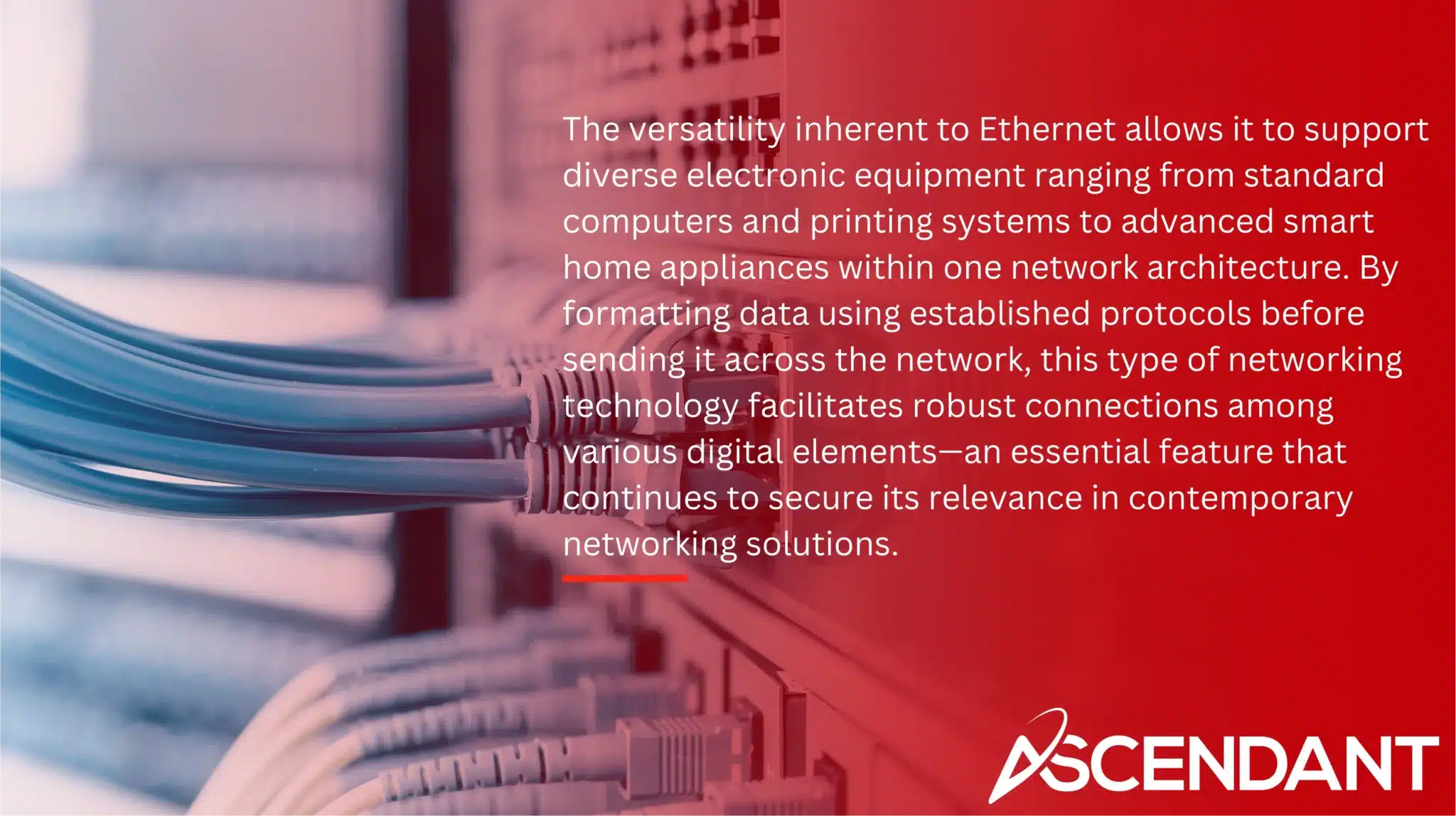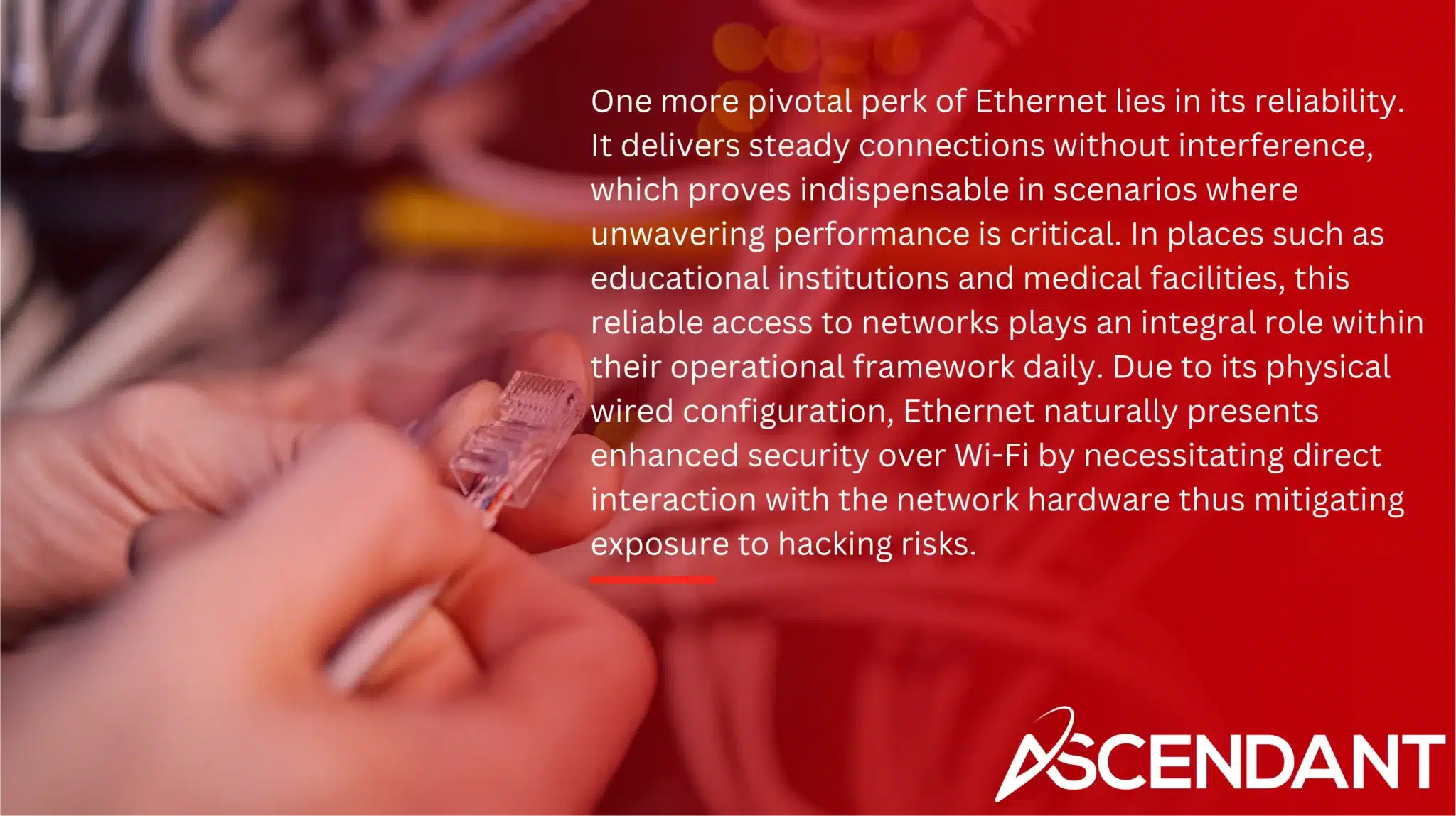Ethernet is a wired networking technology known for its stable and interference-free connections. Unlike Wi-Fi, Ethernet uses cables, making it ideal for environments requiring consistent high-speed performance. This guide covers the benefits, types, and common uses of Ethernet to illustrate its ongoing importance in modern networking.
Key Takeaways
- Ethernet is a foundational technology for wired networking, renowned for its reliability, security, and ability to handle high-speed data transmission across various environments.
- The evolution of Ethernet technology has led to significant advancements in data transfer rates, ranging from 10 Mbps in its inception to potential speeds of 100 Gbps and beyond, adapting to growing demands.
- Ethernet’s major benefits include superior speed, stable connections, and security compared to wireless alternatives, making it an ideal solution for professional settings, data centers, and applications requiring consistent network performance.
Understanding Ethernet
Ethernet networks form the backbone of most wired networking infrastructures, enabling communication and data exchange between connected devices. This technology has been pivotal since its inception in the 1970s for both local area networks (LAN) and wide area networks (WAN), providing swift transmission rates. To connect these devices within a network, Ethernet employs several cable types such as coaxial and fiber optic cables.
Though wireless technologies have surged in popularity, Ethernet still stands out when a stable connection devoid of interference is required. Its reputation for reliability makes it an optimal choice for settings that demand uninterrupted service and high levels of security – qualities especially critical to operations in data centers where handling substantial quantities of information seamlessly is essential.

The versatility inherent to Ethernet allows it to support diverse electronic equipment ranging from standard computers and printing systems to advanced smart home appliances within one network architecture. By formatting data using established protocols before sending it across the network, this type of networking technology facilitates robust connections among various digital elements—an essential feature that continues to secure its relevance in contemporary networking solutions.
Evolution of Ethernet Technology
Ethernet’s origin traces back to 1973 when Robert Metcalfe at Xerox PARC envisioned a novel method for linking computers. This pioneering concept led to the development of the inaugural Ethernet standard by IEEE 802.3 in 1983, enabling data transfer speeds of up to 10 Mbps and igniting a revolution in networking technology.
As demand for greater bandwidth surged over years, Ethernet technology has consistently advanced. The advent of Gigabit Ethernet (1000Base-T) in 1998 represented a monumental stride with capabilities reaching as high as 1 Gbps. Accelerating IEEE sanctioned standards for ethernet offering blistering rates up to 100 Gbps by the year 2017. Present efforts are geared toward attaining unprecedented velocities ranging from 800 Gbps to an exhilarating terabyte per second rate—a testament to Ethernet’s extraordinary versatility.
The introduction of cutting-edge features like encryption has significantly bolstered ethernet performance, fostering better compatibility among devices while amplifying overall functionality. As it persists in evolving and diversifying its applications across various settings, Ethernet maintains its status as an indispensable pillar within the realm of networking technologies.
How Ethernet Works
Ethernet functions at both the data link and physical layers, which are Layer 1 and Layer 2 respectively, in accordance with the OSI model. The role of the physical layer is to convey electrical signals over cabling systems that connect various devices, thus allowing for data transfer. Meanwhile, ensuring error detection and correction processes maintain integrity is a job for the data link layer as it oversees packet transmission between those devices.
At its core lies Ethernet’s CSMA/CD protocol critical for regulating how information is sent across a network while mitigating signal collisions. Within Ethernet frames, there are specific sequences of bits marking beginnings and endings of packets to promote structured communication flow. Control over when each device may transmit falls under the responsibility of MAC sublayer within these data link layers, this effectively bolsters overall network performance.
Data encapsulation in Ethernet frames includes not just payload but additional relevant details aimed at smoothing out interactions among interconnected hardware components. Through implementing collision avoidance techniques along with logical connection management protocols like Logical Link Control (LLC), Ethernet manages to deliver transmissions proficiently without compromising on dependability – qualities which underline its widespread adoption in contemporary networking practices.
Key Components of an Ethernet Network
An ethernet network operates efficiently through the integration of several essential components. Central to its architecture is the Ethernet cable, which serves as a conduit for transmitting data. There are various types of Ethernet cables available, such as twisted pair, fiber optic, and coaxial. Each selected based on their distinctive properties and application needs. Specifically, twisted pair cables are favored due to their capacity to negate interference and bolster signal quality.
The inclusion of Ethernet ports also plays an indispensable role by allowing devices to join wired networks. Commonly installed in routers, switches, modems, and other equipment, these ports utilize an 8P8C connector or RJ45 that ensures a stable connection by firmly anchoring the cable. Electrical and electronics engineers particularly depend on these interfaces for efficient networking connectivity, which can be streamlined with Ethernet switches including singular switch units.
Lastly, but importantly, come network switches themselves, which are imperative within the scope of managing data flow between interconnected devices across one network while concurrently offering supplementary access points for system scaling-up purposes.
Types of Ethernet Cables
Within an Ethernet network, several different types of Ethernet cables are utilized, each tailored to fulfill distinct performance requirements and specific uses. Twisted pair cables, fiber optic cables, and coaxial cables represent the primary varieties available. Each category has its own set of benefits and is appropriate for varied roles within the structure of an Ethernet network.
To delve deeper into these categories:
Twisted Pair Cables
Ethernet networks frequently rely on twisted pair cables, which consist of pairs of copper wires entwined to diminish interference. These come in two principal varieties: unshielded twisted pair (UTP) and shielded twisted pair (STP). Despite being more prone to noise from electrical sources, UTP cables are widely favored due to their affordability and simpler installation process.
Different grades of these twisted pair cables accommodate varying levels of network performance. For instance, Cat5 cabling is designed for Fast Ethernet environments supporting speeds as high as 100 Mbps. On the other hand, Cat5e and Cat6 variants enhance speed capabilities while also minimizing interference. To cater to settings that demand even higher performance levels with up to 10 Gbps throughput, advanced versions such as Cat6a or Cat7 cabling offer an optimal solution.
Fiber Optic Cables
Utilizing slender strands of glass, fiber optic cables enable the transfer of data at velocities reaching gigabit levels and stand as a testament to the apex of networking technology. Their resilience against electromagnetic interference renders them exceptionally reliable in areas susceptible to electrical disturbances. These fiber optics are adept at facilitating 10 Gigabit Ethernet connections for stretches up to 10 kilometers, thereby accommodating both high-speed communication and extensive reach.
In scenarios where there is intense demand such as backbone networks and data centers, the deployment of fiber optic cables has become more prevalent due to their capacity for preserving signal fidelity across extended distances while supporting swift data transmission rates. This makes them an essential element within contemporary networking infrastructures.
Coaxial Cables
Ethernet networks historically favor the use of coaxial cables, especially in earlier standards such as 10Base2 and 10Base5, which provided reliable operation at speeds reaching 10 Mbps.
Nevertheless, with the introduction of improved cabling technologies like twisted pair and fiber optic, coaxial cables have substantially declined in popularity for current Ethernet uses.
Ethernet Speed and Performance
An ethernet network’s efficacy is chiefly influenced by the speed at which its elements operate. Over time, ethernet technology has progressed to accommodate speeds ranging from 1 Gbps up to a staggering 400 Gbps. This evolution addresses the increasing demand for swift data transmission across different environments.
Operating at speeds of 100 Mbps, Fast Ethernet is adept for handling multimedia applications and routine networking tasks. In contrast, Gigabit Ethernet provides a transfer rate of 1 Gbps and serves ideally in settings that require high-level network performance. Meanwhile, enterprise backbone networks gain substantially from utilizing 10 Gigabit Ethernet with its capacity to manage data throughput rates as fast as 10 Gbps—this guarantees both strong and dependable functionality.
The choice of cabling significantly affects an Ethernet system’s efficiency. Fiber optic cables are often pivotal for maintaining top-tier performance over large-scale networks due to their proficiency in facilitating rapid data transfers without signal degradation. Consequently, this renders Ethernet an exceptionally adaptable and formidable networking technology suitable for a broad array of application requirements.
Ethernet vs. Wi-Fi
Discussions around choosing between Ethernet and Wi-Fi typically revolve around considerations of speed, dependability, and ease of use. Ethernet connections involve physical wiring to link devices together, which ensures a stable connection free from disruptions. This characteristic renders it particularly well-suited for scenarios that demand uninterrupted performance like online gaming or in professional contexts.
Contrarily, Wi-Fi communicates data through the emission of high-frequency wireless signals without the need for cables. It provides users with the advantage of easy configuration and freedom to move around. Its susceptibility to external interference can cause signal weakening, especially across extended ranges. Consequently, this may result in diminished speeds and reliability when contrasted with wired Ethernet connections.
Selecting either Ethernet or Wi-Fi should therefore be informed by an assessment of what is most important within a given network setup: whether that’s ensuring persistent stability or valuing flexible access points throughout a space.
Benefits of Using Ethernet
Ethernet connectivity offers a range of advantages that contribute to its widespread adoption in various network settings. The capability of Ethernet connections to support data transmission speeds reaching 100 Gbps greatly exceeds what is typically available with wireless alternatives, making it exceptionally beneficial for professional environments where the need for substantial bandwidth is imperative.

One more pivotal perk of Ethernet lies in its reliability. It delivers steady connections without interference, which proves indispensable in scenarios where unwavering performance is critical. In places such as educational institutions and medical facilities, this reliable access to networks plays an integral role within their operational framework daily. Due to its physical wired configuration, Ethernet naturally presents enhanced security over Wi-Fi by necessitating direct interaction with the network hardware thus mitigating exposure to hacking risks.
For activities demanding low latency and continuity like online gaming, Ethernet stands out as a preferred choice because it resists electromagnetic disturbance well leading to purer signal transmissions and superior quality during data exchanges. All these attributes—remarkable speed capabilities coupled with steadfast reliability and heightened security—solidify Ethernet’s standing as an essential component within contemporary networking infrastructure.
Limitations of Ethernet
Ethernet, while advantageous in various ways, is not without its shortcomings. A notable drawback lies in the constraints of cable length. For instance, Cat5 Ethernet cables are restricted to a maximum distance of 324 feet before their performance degrades due to interference, which can compromise connection quality.
The complexity and cost involved in implementing Ethernet networks present Obstacles. The setup process can be particularly intricate and expensive for expansive or elaborate setups. Despite these difficulties, enhanced versions of Cat6 cables have proven effective at providing dependable performance even under strenuous conditions, offering some relief from these limitations.
Power Over Ethernet (PoE)
Power over Ethernet (PoE) represents a cutting-edge technology that permits network devices to draw electrical power via an ethernet cable, thereby obviating the necessity for individual power sources. This innovation streamlines the configuration of networks and augments flexibility in device positioning because there’s no requirement for proximity to electrical outlets.
To facilitate this distribution of electricity, PoE employs conventional ethernet cables alongside tools like injectors or specialized PoE-enabled network switches. The centralization of power enables support through an uninterruptible power supply (UPS), bolstering the steadfastness of the network.
PoE ensures that connected devices are safeguarded from potential hazards such as overload or improper setup, contributing to operational safety within networking environments.
Common Uses of Ethernet
Ethernet is renowned for its dependability and efficacy, making it the preferred choice in a variety of environments. At home, Ethernet serves as a vital connection hub for devices such as personal computers, video game consoles, and intelligent televisions to obtain stable internet access. It delivers continuous and fast connectivity crucial for activities that demand high-speed data transfer like video streaming and online gaming.
In workplace settings, Ethernet plays an essential role by linking numerous gadgets within a local area network (LAN). This setup promotes seamless communication and sharing of information among employees, thereby boosting workplace efficiency.
Data centers extensively employ Ethernet due to its strong capability in managing substantial amounts of data movement. This is particularly important in backbone networks where there’s a necessity for transmitting data at swift speeds.
Setting Up an Ethernet Network
Initiating an Ethernet network is a simple task that involves minimal technical know-how and the necessary components. Begin by confirming that your router has been appropriately linked to the modem and indicates it’s connected to the internet. Following this, plug in an Ethernet cable from your computer directly into the router. This should grant you access to the internet almost instantaneously.
Should issues arise with connectivity, consider switching to an alternate Ethernet port on your router or testing a different Ethernet cable. Although setup might present difficulties when dealing with expansive distances, investing in initial installation costs for Ethernet can ultimately lead to substantial savings as it eliminates reliance on multiple wireless routers and additional hardware equipment.
Future of Ethernet Technology
Advancements in Ethernet technology are poised to deliver exhilarating progress with an aim of reaching data transfer rates as rapid as 100 Gbps. This will ensure that the escalating needs for services like cloud computing and high-definition video streaming can be met with ease, thereby cementing Ethernet’s status at the forefront of networking technologies.
As Ethernet progresses, its merging with fiber optic technology is becoming increasingly common, facilitating swift movement of data across extended distances while maintaining quality. The ongoing evolution of Ethernet ensures it maintains its vital role in contemporary networking infrastructure by keeping pace with continuously expanding requirements.
Summary
Ethernet has proven to be a reliable and powerful networking technology, evolving to meet the demands of modern data transmission. From its humble beginnings to its current high-speed capabilities, Ethernet continues to be an essential tool in homes, offices, and data centers. As we look to the future, Ethernet will undoubtedly play a key role in the ever-expanding world of connectivity.
Frequently Asked Questions
What is Ethernet and why is it important?
Ethernet is a vital networking technology that connects devices in wired networks, offering stable and high-speed connections essential for reliable data transmission. Its importance lies in its ability to support efficient communication in both residential and commercial environments.
What are the key differences between Ethernet and Wi-Fi?
The key difference is that Ethernet relies on physical cables for stable and faster connections, whereas Wi-Fi provides wireless access, enhancing mobility, but typically resulting in lower reliability and speed.
What are the main types of Ethernet cables?
Ethernet cables come in various forms, including twisted pair cables (examples include Cat5 and Cat6), fiber optic cables, and coaxial cables.
These different types of ethernet cabling are used based on the specific needs for performance and the distance over which data transmission is required.
How does Power over Ethernet (PoE) work?
Power over Ethernet (PoE) simplifies the installation process by allowing electrical power to be transmitted along with data via Ethernet cables, eliminating the need for additional power supplies. This technology enhances flexibility in positioning devices as it combines both power and connectivity into a single source.
What are the future trends in Ethernet technology?
Future trends in Ethernet technology will focus on achieving higher data transmission rates, potentially reaching up to 100 Gbps, and increasing the integration of fiber optic technology for enhanced long-distance data transfer capabilities.


